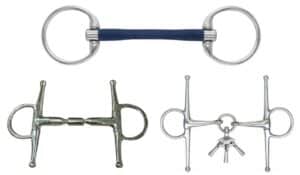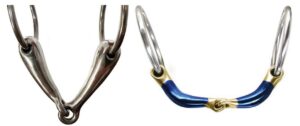Bits For The Breaker
There’s much to consider as you begin acquainting your youngster with the feel and use of a bit, writes ANNA MINOGUE.
It’s more than fair to say that with all the various types of bits available, the severity of each and every one lies in your hands. As riders, that’s something we all should keep firmly in mind, no matter how old our horses are. And for a young horse being introduced to a bit for the first time, the obvious choice is to opt for one that offers the greatest degree of comfort, and is as safe for that young mouth as possible.
Setting the scene
Before going into greater detail on bits for your young horse, I should first explain why bits and their correct fit are my passion.
I’ve owned and ridden horses for 30 or so years. I was a veterinary nurse for 15 years, and in 2011, I qualified as an equine dentist. It was while working in that profession that I saw numerous mouth injuries caused by bits, which set me off on a new trajectory. I studied first with The International College for Professional Bit Fitting Consultants in The Netherlands, before undertaking courses with Horse Bit Fit UK and with Bombers Bits, at Neue Schule’s The Academy, and with others.
I do not work for a bitting company, nor do I work for a shop or a brand – and this is because I prefer to give an unbiased opinion about the bit and brand I think will be the best option for you and your horse. Essentially, my goal as a bit fitter is to make horses more comfortable and to improve their performance through an ethical approach to bits and bridles, and by teaching riders, who are sometimes frustrated by a lack of results after using increasingly severe bits, that there’s a better approach.
But back to young horses and their bits. The first point I’d like to make is the importance of building a huge amount of confidence around the bit, educating the horse so they learn to be soft into the contact and are happy to follow the contact and the bit without taking advantage of it. Basically, it’s all about making sure that they’re comfortable and confident with the feeling of a bit in their mouth, and that you, as the rider, don’t make any erratic movements, or apply constant and unrelenting pressure, which is one way to really distress a horse. Building trust and confidence in the bit is a number one priority.

TOP: Bomber Moulded Mullen – great for developing a soft contact in a more sensitive horse. LEFT: TBF 14mm Full Cheek Barrel Bit –
the sides are good for direct steering and for stopping the bit moving laterally. RIGHT: Avoid ‘key’ bits, or any that encourage the horse
to fiddle with the bit. Once they’ve learned to ‘play’ with the bit, achieving a quiet mouth and steady contact is very hard.
When it goes wrong
I commonly see problems that have originated either in the breaking process or during training, and are the result of practices such as applying constant and unrelenting pressure; using a sudden and strong pressure (using a ten when you could have used a two); not escalating pressure in an appropriate way; and pulling on the mouth for no reason and with no aid in mind. You’ll sometimes see riders jab on their horse’s mouth, and if that’s done when a horse is a breaker, or very early on in their education it will absolutely destroy any confidence in the bit.
If a horse lacks that confidence, you’ll get anxiety around the bit which will manifest in behaviours such as chewing the bit, which can be a big and ongoing problem; leaning into the bit; backing off the bit; overbending with the bit – any one of a number of evasive behaviours in which they’re trying to get away from the pressure of the bit because they’ve never been taught what it means.
A bit is a communication tool, not a control tool. It’s the way to communicate whether I want their shoulder to move over, whether I want them to go into the hand, whether I want them to stretch down into the contact, and so on. It’s all about communication, but a lot of horses are trained with a bit that has been used as a method of control, and from that you usually don’t get a positive outcome. They’re often quite anxious because too much pressure has been applied or applied too quickly. Worse still, horses can continue to be anxious around the bit and to manifest those behaviours for their entire ridden careers if they haven’t been properly trained right from the start.
From the ground up
For breakers, I like the Bombers Moulded Mullen, provided your horse won’t turn it into rubbery snack! At around 16mm it’s quite thin for a rubber bit, and it’s very flexible.
Another thing to consider is the size of your bit, I see far more injuries and wounds from bits that are too large than too small, even when there is little pressure on the reins. I generally try and use a bit that doesn’t have a lot of movement in it – something like a Myler, a barrel bit, can be quite good for that reason. On the other hand, a bit with a lot of movement, such as a double-jointed snaffle, can be too much for a lot of horses, making them very anxious. Personally, I prefer not to use that type of bit until a horse is confident and well established in the contact.
Similarly, I don’t use jointed bits on young horses because at some point, you may have to apply quite strong pressure. If you want them to turn right then they have to turn right, and you might need to open your right rein quite dramatically. With a double-jointed bit that might cause a lot of lateral movement – the bit will slide all the way over and those little joints can pinch on the inside of the lips and cause a bit wound.
Other than a rubber bit, I do like the full cheek 14mm thick barrel bit I had made (10mm bits are too thin – 12 to 14mm is preferable for a young horse). But you do need some kind of direct steering, and a correctly fitted full cheek design prevents the lateral movement common with eggbutts and loose ring bits, even when you do open a rein. And ergonomically speaking, it’s preferable that when you hold a bit up by its rings, it falls naturally into a ‘U’ shape rather than a ‘V’. The canons in a ‘V’ shaped bit tend to be too straight and will not encourage the horse to get a feel for the bit and thus gain confidence.

It’s preferable that when you hold a bit up by its rings, it falls naturally into a ‘U’ shape (right) rather than a ‘V’ (left). The canons in a
‘V’ shaped bit tend to be too straight and will not encourage the horse to get a feel for the bit and thus gain confidence
Getting educated
Once your youngster is established in the basics, it may be appropriate to change their bit to one that allows for a little more finesse. Calling in a bit fitter at this point is a good idea. They will assess factors such as the shape and formation of the horse’s mouth (do they have a skinny tongue or particularly wide bars?); their anatomy and biomechanics; their level of training; your level of skill; and how you and your horse function as a pair.
A horse needs to learn to connect with the bit and communicate with it, rather than be frightened of it. And of course, rider’s make mistakes, perhaps they’re unsteady in the hands, or they ask for a half halt when they didn’t mean to – the horse has to be confident enough in the bit that they forgive all that – but if they’re fearful of it, then they don’t forgive those mistakes and become quite frightened of the bit.
It’s about communication
In closing I would stress that when you’re choosing a bit for your breaker, look for one that moves very little in the mouth; is not too thin (shoot for 12-14mm); falls into a ‘U’ rather than a ‘V’ shape; and consider a full cheek to help prevent the bit sliding and causing injury. Finally, remember that a bit is all about communication, not control. More often than not, a stronger bit is not the answer, better education and greater understanding of, and confidence in the bit is.
As riders, I think we all need to take greater responsibility for how our horses are in the contact. And remember, generally speaking if there’s a problem it’s not always the rider’s fault, nor is it always the horse. It’s a combination of you both – it’s always a combination.
Anna is based in Chambers Flat, Queensland. To learn more about the expert services she offers, you can reach her at The Bit Fitter, through her Facebook page, or call 0407 689 155.



